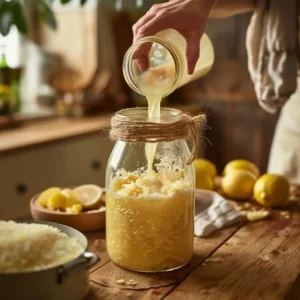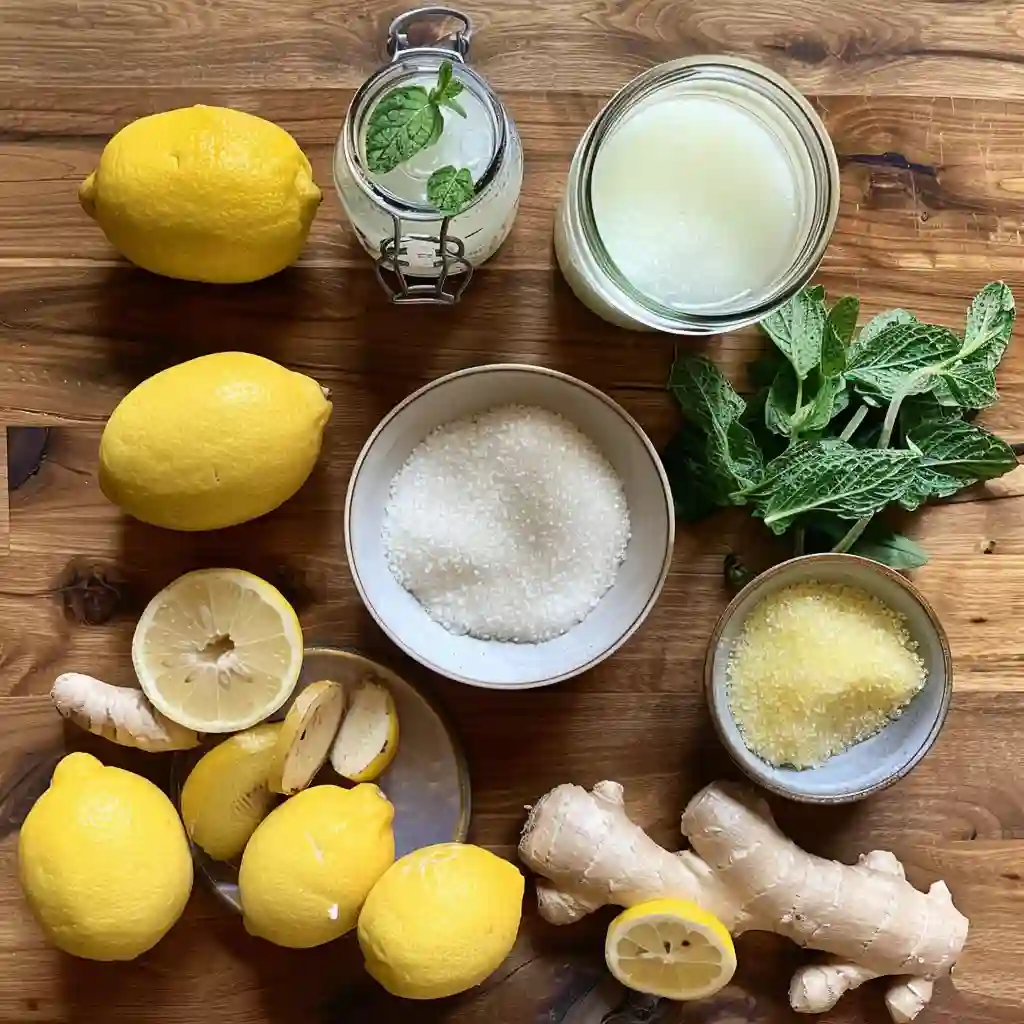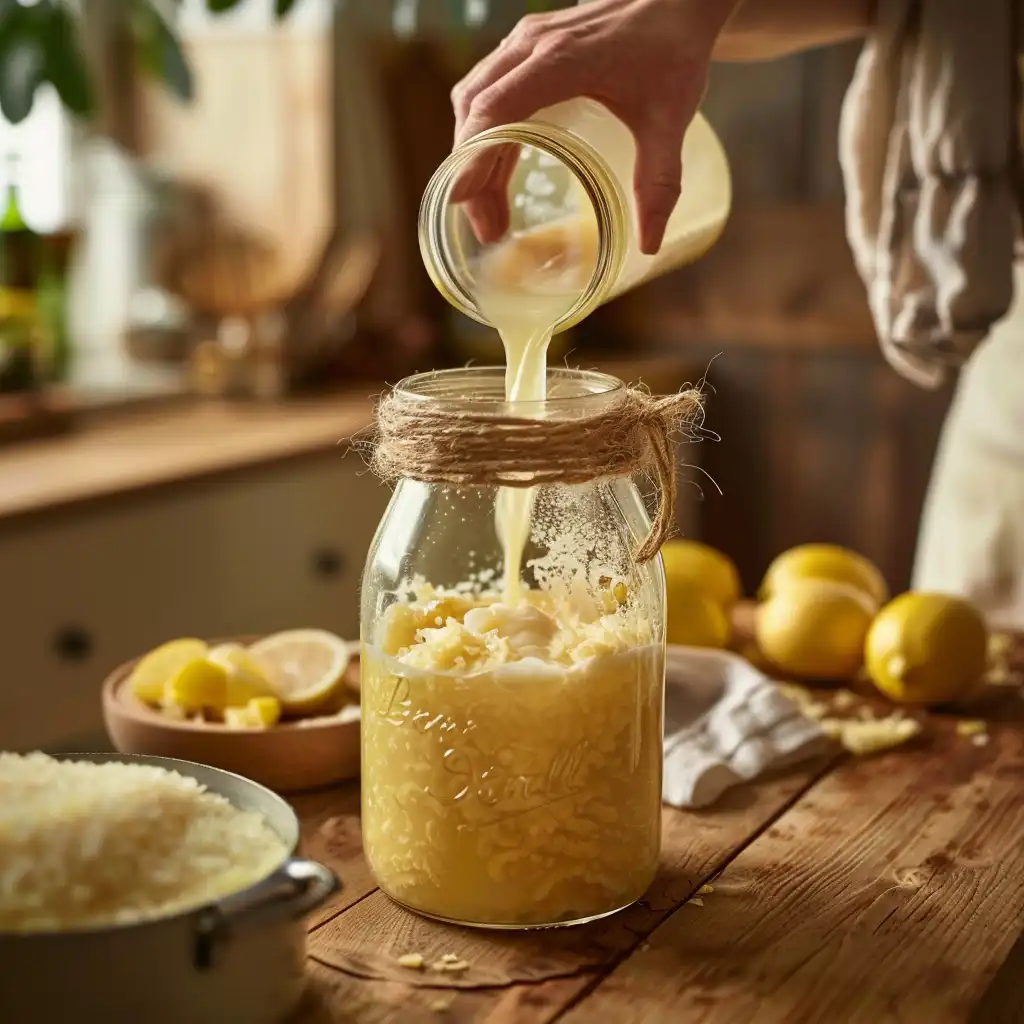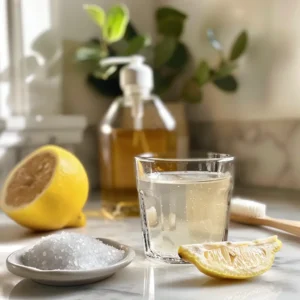Ever stumbled upon a drink that’s tangy, slightly bubbly, and secretly works wonders for your gut? That’s what happened to me when I first tasted Fermented Probiotic Lemonade on a food walk in San Francisco. It wasn’t just refreshing—it felt alive. As someone who’s always curious about traditional food remedies across cultures, I dove into fermenting my own. What followed was a fizzy adventure through flavors, gut health, and kitchen science.
In this guide, I’ll share what I’ve learned—how fermented lemonade boosts digestion, why probiotics are so much more than a trend, and how you can easily make it at home. You’ll also discover how it tastes, whether it’s safe for kids, and tips to avoid fermentation flops. If you’re ready to trade sugary sodas for a natural probiotic fizz, I’ve got you covered.
Let’s jump into the fizzy world of fermented lemonade.
Table of Contents
What Is Fermented Probiotic Lemonade?
The Basics of Fermentation in Lemonade
So what exactly is fermented probiotic lemonade? It’s a naturally carbonated beverage made by combining fresh lemon juice, sugar, and a probiotic culture—usually whey, ginger bug, or water kefir. Over time, the beneficial bacteria consume the sugars and produce lactic acid and carbon dioxide, giving it a tangy flavor and gentle fizz.
This fermentation process is called lacto-fermentation. It’s been used for centuries in everything from Korean kimchi to German sauerkraut. When applied to lemonade, it transforms a basic citrus drink into a probiotic powerhouse.
But this isn’t the overly sweet lemonade you’re used to. Instead, it’s a living drink filled with naturally occurring bacteria that support your gut microbiome. The process is simple, safe, and can be done right in your kitchen—no fancy gear needed.
Difference Between Probiotic Lemonade and Regular Lemonade
Traditional lemonade is all about the trio: lemon juice, water, and sugar. It’s sweet, tangy, and refreshing—but it’s also high in sugar with no beneficial microbes.
Fermented probiotic lemonade, on the other hand, swaps that sugar spike for a slightly sour, lightly sweetened, and fizzy alternative. What really sets it apart is the live cultures. These are the “good” bacteria (like lactobacillus) that aid digestion and boost immunity.
Here’s a quick comparison:
| Feature | Regular Lemonade | Fermented Probiotic Lemonade |
|---|---|---|
| Taste | Sweet & tangy | Tart, tangy, slightly fizzy |
| Sugar | High | Lower (as it’s fermented) |
| Probiotics | None | Yes – live cultures |
| Shelf Life | Short (fridge only) | Longer (kept fermented) |
| Gut Health | No benefit | Excellent for digestion |
So if you’re craving more than just refreshment, probiotic lemonade delivers both flavor and function.
What Is Fermented Probiotic Lemonade?
The Basics of Fermentation in Lemonade
Fermented probiotic lemonade is more than just lemonade with a fancy label. It’s a naturally carbonated drink made by fermenting lemon juice, water, and a source of sugar using live cultures like whey, ginger bug, or water kefir grains. The fermentation process is a natural reaction where the beneficial bacteria consume the sugars and release carbon dioxide and acids, creating a fizzy, tangy, and probiotic-rich beverage.
In many cultures, fermentation is a long-respected tradition—used not only to preserve food but to enhance nutrition and gut health. When applied to something as simple as lemonade, the result is a slightly sour, slightly sweet, and gently effervescent tonic that feels more like a craft soda than a health drink.
When I first tried fermenting at home, I started small—with half a jar and lots of trial and error. I quickly learned that even the temperature of your kitchen or the kind of sugar you use can change the flavor profile. That’s the beauty of fermentation: it’s alive, evolving, and personal.
Difference Between Probiotic Lemonade and Regular Lemonade
To appreciate the benefits, let’s compare the standard sugary lemonade most of us grew up with and this fermented version I’ve come to love:
| Feature | Traditional Lemonade | Fermented Probiotic Lemonade |
|---|---|---|
| Main Ingredients | Lemon juice, water, sugar | Lemon juice, water, sugar, live culture |
| Taste | Sweet & tart | Tart, slightly fizzy, tangy |
| Sugar Content | High | Lower (sugar consumed by bacteria) |
| Probiotics | None | Yes, naturally occurring |
| Shelf Life | Short, needs refrigeration | Longer due to acidity & beneficial bacteria |
| Health Benefits | Minimal | Supports digestion, immunity, gut health |
Regular lemonade is basically sugar water with a citrus zing. Fermented lemonade, on the other hand, is a probiotic drink that can genuinely support your microbiome. It contains live, beneficial bacteria, like Lactobacillus, that help balance the gut and promote overall health.
If you’re into DIY projects or simply love experimenting in the kitchen, making your own probiotic lemonade is incredibly satisfying—and yes, fun too.
Print
Fermented Probiotic Lemonade – A Gut-Healthy, Fizzy Superdrink You’ll Love
A fizzy, tangy, gut-friendly drink that’s as refreshing as it is good for your digestion. Homemade fermented lemonade is your bubbly step into the world of probiotics.
- Total Time: 10 minutes active, 2–3 days fermentation
- Yield: 6–8 servings 1x
Ingredients
- 6 cups of filtered water
- 1 cup of freshly squeezed lemon juice (about 4–6 lemons)
- 1/2 to 3/4 cup organic cane sugar
- 1/4 cup whey, ginger bug starter, or water kefir grains
- Optional: lemon zest, ginger slices, or mint leaves
Instructions
- Dissolve sugar in 1 cup of warm water in a large glass jar or pitcher.
- Add the lemon juice and remaining water, then let the mixture cool completely.
- Stir in your starter culture (whey, ginger bug, or kefir grains).
- Cover the jar with a clean cloth or paper towel secured with a rubber band.
- Leave it at room temperature (around 70°F/21°C) for 2–3 days.
- Taste daily—once it’s fizzy and slightly tangy, it’s ready to bottle.
- Transfer to airtight bottles and refrigerate to stop fermentation.

Notes
Always use filtered or non-chlorinated water. Avoid metal utensils when handling cultures. Fermentation time affects taste and fizz—refrigerate when it’s just right for you.
- Prep Time: 10 minutes
- Cook Time: 0 minutes
- Category: Drink
- Method: Fermented
- Cuisine: Probiotic
Nutrition
- Serving Size: 1 cup
- Calories: 45
- Sugar: 6g
- Sodium: 5mg
- Fat: 0g
- Saturated Fat: 0g
- Unsaturated Fat: 0g
- Trans Fat: 0g
- Carbohydrates: 11g
- Fiber: 0g
- Protein: 0g
- Cholesterol: 0mg
Health Benefits of Fermented Probiotic Lemonade
Why Probiotics Matter for Gut Health
One of the main reasons I started making fermented probiotic lemonade was to improve my gut health. I’d read articles and heard experts rave about probiotics, but I didn’t realize how powerful they really are until I began drinking this fizzy, lemony tonic regularly. After just a week of sipping my homemade batch daily, I noticed better digestion, less bloating, and even a more stable mood.
But what are probiotics, really? They’re live microorganisms—mainly bacteria and yeasts—that help maintain or restore healthy gut flora. Think of your gut as a bustling city; probiotics are the good citizens keeping everything clean, functional, and efficient. A balanced gut can influence everything from digestion and immune strength to brain function and inflammation control.
Fermented probiotic lemonade provides a natural, non-dairy source of these beneficial bacteria—perfect for anyone lactose intolerant or avoiding yogurt or kefir. And because it’s made with fresh lemons, you’re also getting vitamin C, antioxidants, and enzymes that support your immune system.
When the probiotics in fermented drinks like this one reach your gut, they:
- Improve nutrient absorption
- Aid in breaking down complex foods
- Help regulate bowel movements
- Reduce symptoms of IBS and bloating
That’s a whole lot of benefit from something that tastes like a craft soda. It’s no wonder more people are turning to fermented probiotic lemonade as a natural way to support gut wellness and energy.
Detox, Digestion, and Immunity Perks
Now, let’s go deeper into what fermented probiotic lemonade can do beyond gut health. Thanks to the enzymes, acids, and live cultures, drinking this tangy elixir can also support natural detoxification. The acidity from lemons and lactic acid from fermentation help stimulate liver function and flush out toxins more effectively.
From my own experience, I’ve found that drinking it in the morning—on an empty stomach—helps me feel lighter, clearer, and more energized. There’s something special about starting your day with something alive and nourishing that sets a great tone.
And let’s talk about immunity. Around cold and flu season, I always double up on fermented probiotic lemonade and ginger bug sodas. The combination of vitamin C from lemons and probiotic bacteria creates a natural immune booster, helping your body fight off infections and inflammation more effectively.
How to Make Fermented Probiotic Lemonade at Home
Step-by-Step Guide to the Fermentation Process
Making fermented probiotic lemonade at home is easier than most people think. When I first started, I expected something complicated and scientific. But really, it’s just about combining the right ingredients and giving them a bit of time to transform.

Here’s a basic step-by-step guide I’ve perfected over dozens of batches:
Ingredients:
- 6 cups of filtered water
- 1 cup of freshly squeezed lemon juice (about 4–6 lemons)
- 1/2 to 3/4 cup organic cane sugar
- 1/4 cup whey (from yogurt or kefir), ginger bug starter, or water kefir grains
- Optional: lemon zest, ginger slices, mint leaves
Instructions:
- Dissolve sugar in 1 cup of warm water in a large glass jar or pitcher.
- Add the lemon juice, remaining water, and let it cool completely.
- Stir in your starter culture (whey, ginger bug, or kefir grains).
- Cover the jar with a clean cloth or paper towel secured with a rubber band.
- Leave it at room temperature (around 70°F/21°C) for 2–3 days.
- Taste it daily—once it’s fizzy and slightly tangy, it’s ready to bottle.
- Transfer to airtight bottles and refrigerate to stop fermentation.
A few days in the fridge will boost the fizz even more. You’ll get that champagne-like sparkle without the alcohol (well, almost—more on that later).
Ingredients and Equipment You’ll Need
What I love about this recipe is how little equipment it actually requires. Here’s a quick list to help you set up:
| Item | Purpose |
|---|---|
| Glass jar or pitcher | Fermenting vessel |
| Cheesecloth or paper towel | Breathable cover |
| Wooden spoon | For stirring (avoid metal with probiotics) |
| Measuring cups | Accuracy helps! |
| Flip-top bottles | For storing and creating carbonation |
| Lemon squeezer (optional) | Saves time and hand cramps |
As for ingredients, always use filtered or non-chlorinated water. Chlorine can kill off the good bacteria, which defeats the purpose. Stick with organic cane sugar—don’t sub honey unless you’re experienced, as it has antibacterial properties.
If you’re using whey, strain it from plain, live-culture yogurt. For ginger bug, just ferment fresh ginger, sugar, and water for 3–5 days.
Fermented Probiotic Lemonade vs. Store-Bought Probiotic Drinks
Cost, Quality, and Nutritional Comparison
Let’s be honest—store shelves are full of probiotic drinks claiming health miracles. From kombucha to kefir waters to shelf-stable gut shots, the options can be overwhelming. I’ve tried dozens of them, and while some taste great, most fall short on two things: cost and freshness.
When you make fermented probiotic lemonade at home, you’re not only saving money—you’re also getting a fresher, more potent product. A single bottle of store-bought probiotic lemonade can cost $4–$7. But with basic ingredients at home, I can make a whole gallon for about $2.50. That’s not just affordable—it’s empowering.
Let’s compare side-by-side:
| Feature | Homemade Fermented Lemonade | Store-Bought Probiotic Drink |
|---|---|---|
| Cost | Low (under $3/gallon) | High ($4–$7 per bottle) |
| Freshness | Very fresh | Pasteurized or preserved |
| Probiotic Count | High (if used correctly) | Varies, often lower |
| Customization | Full control | Limited to brand options |
| Ingredients | Natural & clean | May contain additives or artificial flavors |
Many commercial drinks are lightly pasteurized to extend shelf life. That’s great for stores, but it often kills off a big chunk of the good bacteria. Homemade lemonade, when kept cold after fermentation, stays alive and vibrant.
Looking for inspiration? Try our internal shower chia seed water—a simple detox drink to kickstart your gut health.
Additives, Sugar Content, and Artificial Ingredients
One thing I always tell people: read the label. Commercial probiotic drinks often sneak in refined sugars, “natural flavors,” gums, and preservatives. These can mess with your gut and counteract the whole reason you’re drinking probiotics in the first place.
With homemade fermented lemonade:
- You control the type and amount of sugar
- You avoid preservatives and stabilizers
- You can flavor it naturally—with herbs, fruit peels, or spices
Some brands even use stevia or fake sweeteners, which can disrupt your gut flora over time. That’s why DIY always wins in my book.
The Taste Profile and Drinking Experience
What Does Fermented Lemonade Taste Like?
The first time I tasted fermented probiotic lemonade, I was expecting something medicinal or overly sour. But what I got was a zippy, refreshing, almost champagne-like fizz that surprised me—in the best way. It’s like lemonade with a twist: lightly tart, subtly sweet, and slightly tangy with a soft sparkle that tickles the tongue.
The flavor evolves depending on how long you ferment it. That’s part of the charm—and why I always recommend sampling at different stages.
Here’s how I’d describe the journey of taste:
| Fermentation Time | Flavor Profile |
|---|---|
| 24 hours | Sweet, mild lemon, barely fizzy |
| 48 hours | Tangy, gently fizzy, balanced sweetness |
| 72+ hours | Sharper tartness, more fizz, subtle sourness |
There’s a natural acidity, thanks to the lemon and the lactic acid created during fermentation. It’s a clean, vibrant flavor that wakes up your taste buds in a way soda never could. When you make fermented probiotic lemonade at home, you’ll notice that it develops a depth of flavor that no store-bought drink can match.
Bonus tip: Add a few slices of ginger, some crushed berries, or a sprig of mint before bottling. The result? A whole new layer of flavor complexity that still keeps the probiotic benefits intact.
Check out more fermented and probiotic ideas in our drinks collection—it’s a goldmine for wellness lovers!
How the Flavor Changes Over Time
One of the most exciting things about fermented probiotic lemonade is that it doesn’t stay the same. Even once it’s bottled and chilling in the fridge, the flavors continue to evolve. Each day adds a new twist—sharper tang, deeper fizz, or more complexity.
Here’s what I’ve learned from my many (many!) batches:
- In the first few days, it tastes like a sweet-tart soda with bubbles.
- After a week or two in the fridge, the tartness deepens and the carbonation builds, giving it a bolder, more fermented taste.
- By week three, if left unopened, the fizz can rival sparkling wine—and the flavor becomes almost citrusy dry.
Just be careful: if you’re fermenting at room temperature and forget to burp your bottle (trust me, I’ve done it), it can pop with excitement when opened. That’s not a flaw—it’s just a sign your drink is alive and thriving!
Personally, I like my fermented probiotic lemonade best after 48 hours on the counter and about 2–3 days in the fridge. It hits that sweet spot—tangy, effervescent, and just slightly sweet.
Alcohol Content and Safety of Fermented Lemonade
Does Fermented Lemonade Contain Alcohol?
Yes—but barely.
Fermented probiotic lemonade does produce a small amount of alcohol during the fermentation process. This occurs when natural sugars are consumed by the beneficial bacteria or yeast, releasing both carbon dioxide and trace levels of ethanol (alcohol).
But here’s the important part: if you’re fermenting your fermented probiotic lemonade for just 1 to 3 days and then storing it in the fridge, the alcohol content usually stays under 0.5%. That’s about the same as a ripe banana or a bottle of kombucha. So no, it won’t get you buzzed, and it’s still categorized as a non-alcoholic beverage by most health and safety standards worldwide.
Still, if you leave your fermented probiotic lemonade out for too long at room temperature, the alcohol level can creep higher—sometimes reaching 1% or slightly more. The longer it sits, the more sugar gets converted to alcohol and acids, intensifying both the sourness and the strength.
| Fermentation Time | Estimated Alcohol % |
|---|---|
| 1–2 days | < 0.3% |
| 3–4 days | ~0.5% |
Personally, I always move my fermented probiotic lemonade into the fridge by day two or three. That’s when it hits that perfect blend of fizz, flavor, and minimal alcohol.
Is It Safe for Kids and Pregnant Women?
This is one of the most common concerns I hear—especially from parents and moms-to-be. And it’s an important one.
Generally speaking, homemade fermented probiotic lemonade that’s fermented for 48 hours or less and properly chilled is safe for kids and pregnant women, as long as it’s prepared in a clean environment and consumed in moderation. The alcohol content is so low, it’s unlikely to have any meaningful effect.
Here are a few safety tips I follow in my own kitchen:
- Always use clean tools and sanitized jars to prevent contamination.
- Avoid over-fermentation if you’re serving it to children or during pregnancy.
- Label your bottles with the date you started fermentation. It helps you monitor taste, fizz, and alcohol potential.
- If in doubt, consult with a pediatrician or healthcare provider—especially for expectant mothers.
When I host brunches or family gatherings, I usually serve the lighter, fresher batch of fermented probiotic lemonade—it’s less tangy, very low in alcohol, and still packed with all those gut-friendly benefits.
Best Ways to Enjoy and Serve Fermented Probiotic Lemonade
Creative Flavor Add-ins and Combinations
One of the reasons I fell in love with fermented probiotic lemonade—aside from its health perks—is how endlessly customizable it is. Once you’ve got the base recipe down, you can get creative with natural flavor infusions that not only taste great but also add nutritional value.
Here are some of my favorite combos:
| Add-in | Flavor Boost | Bonus Benefits |
|---|---|---|
| Fresh ginger slices | Spicy, warming | Anti-inflammatory |
| Mint leaves | Cool, refreshing | Aids digestion |
| Berries (strawberries, blueberries) | Sweet-tart | Rich in antioxidants |
| Cucumber | Light, crisp | Hydrating |
| Lavender buds | Floral, relaxing | Calming properties |
| Hibiscus petals | Tart, fruity | Rich in vitamin C |

To flavor your lemonade:
- Add the herbs, fruit, or spices during the bottling stage (after fermentation).
- Let them infuse in the fridge for 12–24 hours.
- Strain before drinking—or keep them in for a bolder taste.
When I’m hosting guests, I love pouring it into champagne flutes with a sprig of rosemary or a lemon twist. It looks like a fancy cocktail but keeps things totally alcohol-free and gut-friendly.
Discover great ideas like our kefir soda—another probiotic-rich drink with a deeper tang and more fizz.
Storage Tips and Serving Suggestions
Fermented probiotic lemonade is alive—which means how you store it really matters. Here are some of my best practices from brewing weekly batches:
- After fermentation, store your lemonade in airtight glass bottles to preserve carbonation.
- Keep it refrigerated to slow down fermentation and alcohol production.
- Drink within 2–3 weeks for the best balance of flavor, fizz, and probiotic activity.
For serving, I recommend:
- Chilling it well before serving—this enhances the fizz.
- Pouring it gently to preserve bubbles.
- Pairing it with light, sweet snacks or tropical desserts.
And always open bottles over the sink—trust me, I’ve lost more than one shirt to an overly bubbly bottle.
Common Mistakes When Making Probiotic Lemonade
Overfermentation and Spoilage Risks
As much as I love making fermented probiotic lemonade, I’ve had my share of mess-ups—like exploding bottles or a brew that tasted like vinegar instead of lemonade. Fermentation is both art and science, and even small missteps can lead to problems.
Here are the most common mistakes I’ve made (so you don’t have to):
- Letting it ferment too long at room temperature
- Result: Overly sour, sharp taste; higher alcohol; risk of spoilage
- Fix: Taste it daily, and refrigerate when it reaches your preferred tartness.
- Using chlorinated tap water
- Chlorine kills off the good bacteria. Always use filtered or spring water for best results.
- Forgetting to burp sealed bottles
- If you bottle and let it sit unrefrigerated too long, pressure builds up and… boom.
- Fix: Open bottles daily if you’re doing a second fermentation outside the fridge.
- Not sanitizing equipment properly
- Dirty jars, lids, or spoons can introduce bad bacteria or mold. Always clean your gear thoroughly.
If you ever see mold—fuzzy, green, blue, or black—that batch is done. Toss it. Better safe than sorry.
Looking for something rich to reward yourself after a successful batch? Try our baked Oreo cheesecake—it’s creamy, crunchy, and a perfect “celebration” dessert.
Troubleshooting Bubbles, Mold, and Taste
Let’s talk solutions. If your lemonade isn’t behaving how you expected, here’s what might be going wrong and how to fix it:
| Problem | Possible Cause | Quick Fix |
|---|---|---|
| No fizz | Weak starter or cool room temp | Use a more active culture; ferment longer |
| Too sour | Overfermented | Shorten ferment time; dilute with fresh lemonade |
| Mold | Contamination | Discard and sanitize everything next time |
| Off smell (rotten, cheesy) | Spoilage | Discard. Start fresh with clean tools |
| Too sweet | Underfermented | Let it ferment 12–24 more hours at room temp |
My advice? Keep notes. I write down batch dates, room temps, ingredients used, and how it tasted. That way, every batch helps me improve the next one.
Frequently Asked Questions (FAQ)
Is probiotic lemonade good for you?
Yes—fermented probiotic lemonade is incredibly good for you. It combines the antioxidant and immune-boosting properties of fresh lemons with the gut-friendly bacteria created during fermentation. This naturally fizzy drink supports digestion, boosts energy, improves hydration, and helps balance your microbiome.
I drink a small glass of fermented probiotic lemonade every morning, and often another in the afternoon when I need something refreshing but nourishing. It’s my favorite way to support gut health naturally—without relying on capsules or synthetic supplements.
Are fermented probiotics good for you?
Absolutely. Fermented probiotics, like the ones found in fermented probiotic lemonade, are live organisms created through natural fermentation. Unlike many commercial supplements, these probiotic strains come in their most bioavailable form—meaning your body can absorb and benefit from them more effectively.
They assist in digestion, improve bowel regularity, strengthen immunity, and may even improve your mood and mental clarity. Drinking fermented probiotic lemonade is one of the most natural, enjoyable ways to add probiotics to your daily routine.
How much alcohol is in fermented lemonade?
The alcohol content in fermented probiotic lemonade is typically very low—usually less than 0.5% if it’s fermented properly and refrigerated in time. That’s about the same as a ripe banana or a bottle of kombucha.
However, if it’s left out at room temperature for too long, the alcohol level can creep up—sometimes to 1% or more. While still quite low, it’s worth monitoring if you’re serving it to kids or anyone sensitive to alcohol.
I always do a taste test on day two. If it’s got the right level of fizz and tang, I move it to the fridge to halt fermentation and lock in flavor.
What does fermented lemonade taste like?
Fermented probiotic lemonade tastes like a zesty, bubbly twist on traditional lemonade. Expect a bright citrus flavor with a touch of tartness, balanced sweetness, and a subtle natural fizz. It’s refreshing, light, and never cloying.
Depending on how long it ferments, the flavor ranges from mildly sweet and tangy to bold and slightly sour. Some say it tastes like kombucha without the strong vinegary aftertaste. Personally, I find it smoother, cleaner, and way more versatile—especially when I add fresh ginger or mint for an extra layer of flavor.
Conclusion
Making and drinking fermented probiotic lemonade has truly changed how I approach wellness and refreshment. It’s not just about a fizzy drink—it’s about feeling alive, one sip at a time. As someone who loves experimenting in the kitchen and cherishing food traditions from around the world, this drink hits that sweet spot between simplicity and transformation.
From improving digestion to boosting energy, from supporting your immune system to delighting your taste buds, probiotic lemonade is a gift you can give your body—made right in your own kitchen. Whether you’re new to fermentation or already making kombucha or kefir, this recipe is approachable, adaptable, and endlessly delicious.
So here’s to better gut health, bubbly beverages, and the joy of crafting something truly good for you.
And for more fresh ideas, follow me on Facebook and Pinterest.








2 thoughts on “Fermented Probiotic Lemonade – A Gut-Healthy, Fizzy Superdrink You’ll Love”